How Long Does It Take to Develop an App: Full Guide
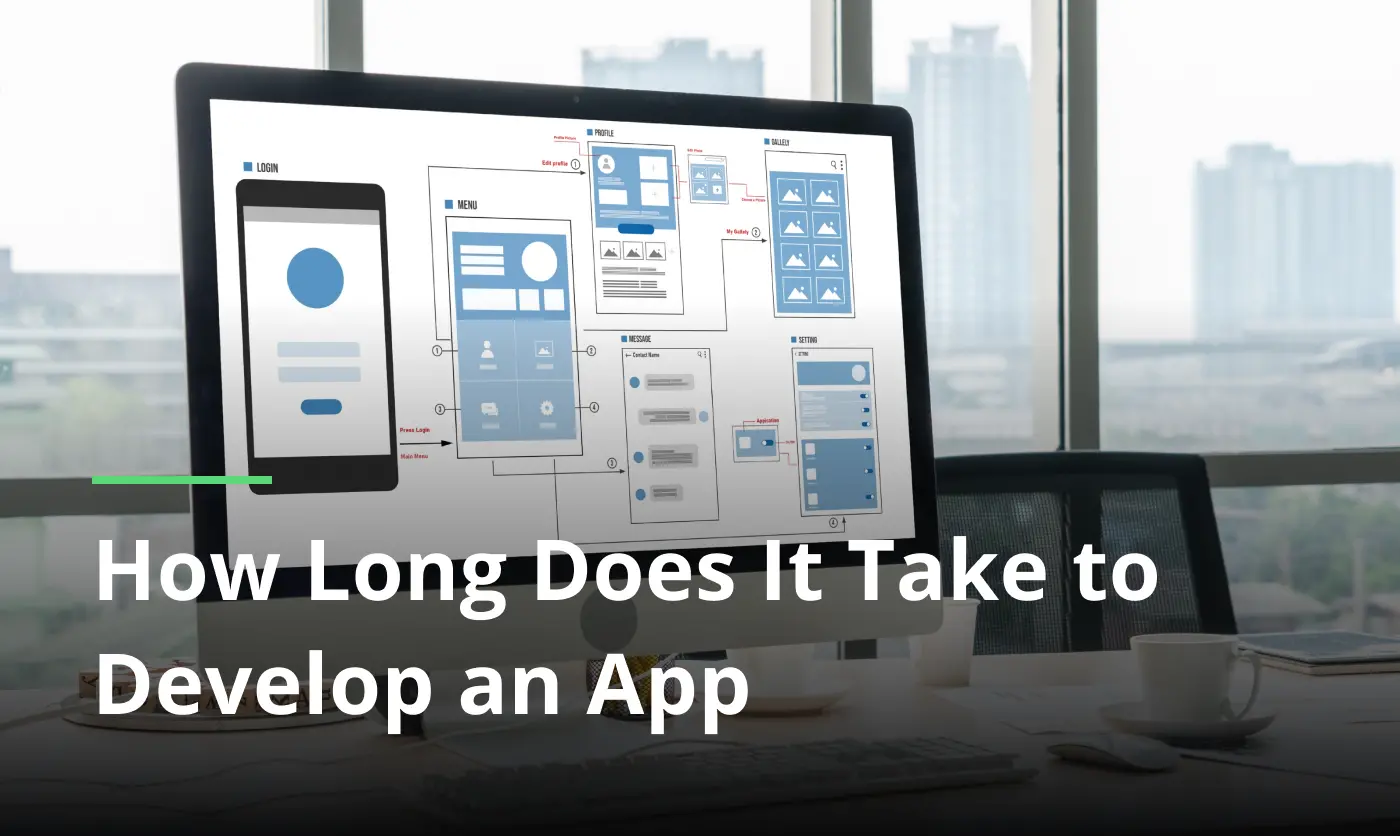
As soon as the wheels start turning on mobile solution creation, one of the first questions that often arises is: “How long will it take?” The app development timeline may alter in a big way based on a variety of factors. Possessing decade-long competence, our team will give you a summary of the most common estimations, breaking down the main elements that determine how much time it takes to turn your idea into a fully functioning app.
Your presence here means that you are wondering how long does it take to build an app and we guarantee — you will get a clue. The answer depends on the requirements and scope of the project, accompanied by the deadlines you aim to meet. Recognizing how different factors influence the sequence will give you a clearer vision of the path ahead.
By the conclusion of this article, you’ll have a solid understanding of your mobile app development timeline and a detailed time breakdown, enabling you to confidently plan each phase of the mobile app development process.
How long does it take to make an app?
The clock starts ticking as soon as you have an idea for an app, but gauging the duration needed to turn that idea into something tangible isn’t always simple. The custom application development process is far from a simple, linear path. Instead, it’s a mix of creativity, technical challenges, blueprint setting. Each stage, from defining your vision to the final launch, adds layers of complexity that impact the overall roadmap.
The scope of your digital product plays a major role in charting the timeline for app development. A simple tool with minimal features may take anywhere from 3 to 6 months to complete. On the other hand, a program with multifaceted modules, like advanced user profiles or eCommerce capabilities, could take 9 to 12 months or longer. In fact, the average production period ranges from 3 to 9 months, but it is all over the map depending on the app’s bells and whistles.
Platform choice has a major bearing on the project’s calendar. If you’re developing for one platform, either iOS or Android, the process will be faster than building for both. A native app for one platform is usually completed within 4 to 6 months, but a cross-platform product may stretch the timeframe to 9 to 12 months.
The skill and experience of your team also play a weighty role. A strong working group with expertise in the relevant technology is able to systematize the process, while a less battle-hardened collective may encounter challenges that extend the completion window. To better understand how the process unfolds, here’s a breakdown of the typical stages of engineering:
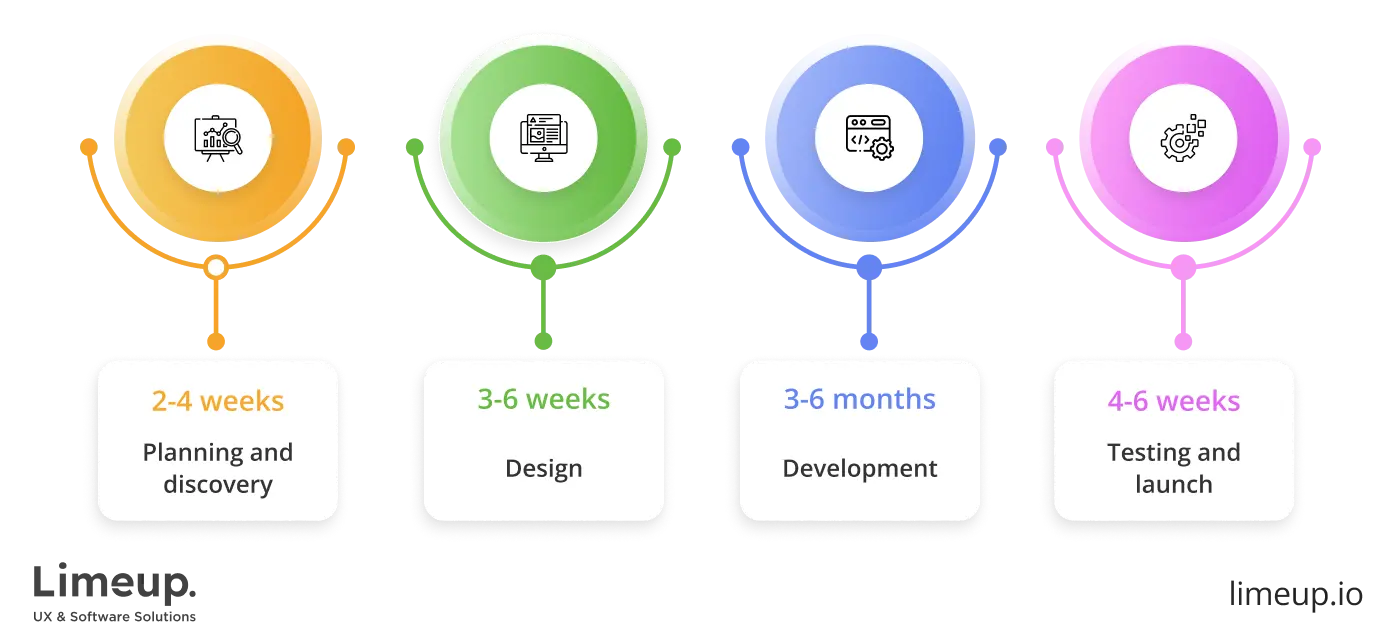
- Planning and discovery (2-4 weeks). This phase sets the foundation for your venture. It involves defining the app’s purpose, identifying user desires and establishing key details. A thorough planning interval helps prevent costly changes later.
- Design (3-6 weeks). In the design milestone, attention is given to creating an app with a visually attractive user interface (UI) and an enjoyable user experience (UX). Since this block drastically impacts success, it demands careful thought and precision.
- Development (3-6 months). This is where the coding and actual creation take place. The time needed for this step depends on the parameters you want to include, on top of how convoluted they are to implement.
- Testing and launch (4-6 weeks). Careful testing guarantees the app is completely bug-free and primed for a successful launch. Here issues are ironed out before the product is released to users.
App engineering is a journey with many steps, and while it’s tempting to rush through the workflow, taking the time to plan, design and test thoroughly will pay off in the end. By understanding each transition and its potential agenda, you are able to set yourself up for a successful launch without unnecessary delays.
What factors affect app development time?
We’ve already touched on the primary influences on the project’s progress, but now let’s discuss some of them more precisely and turn our attention to other critical aspects that also demand attention.
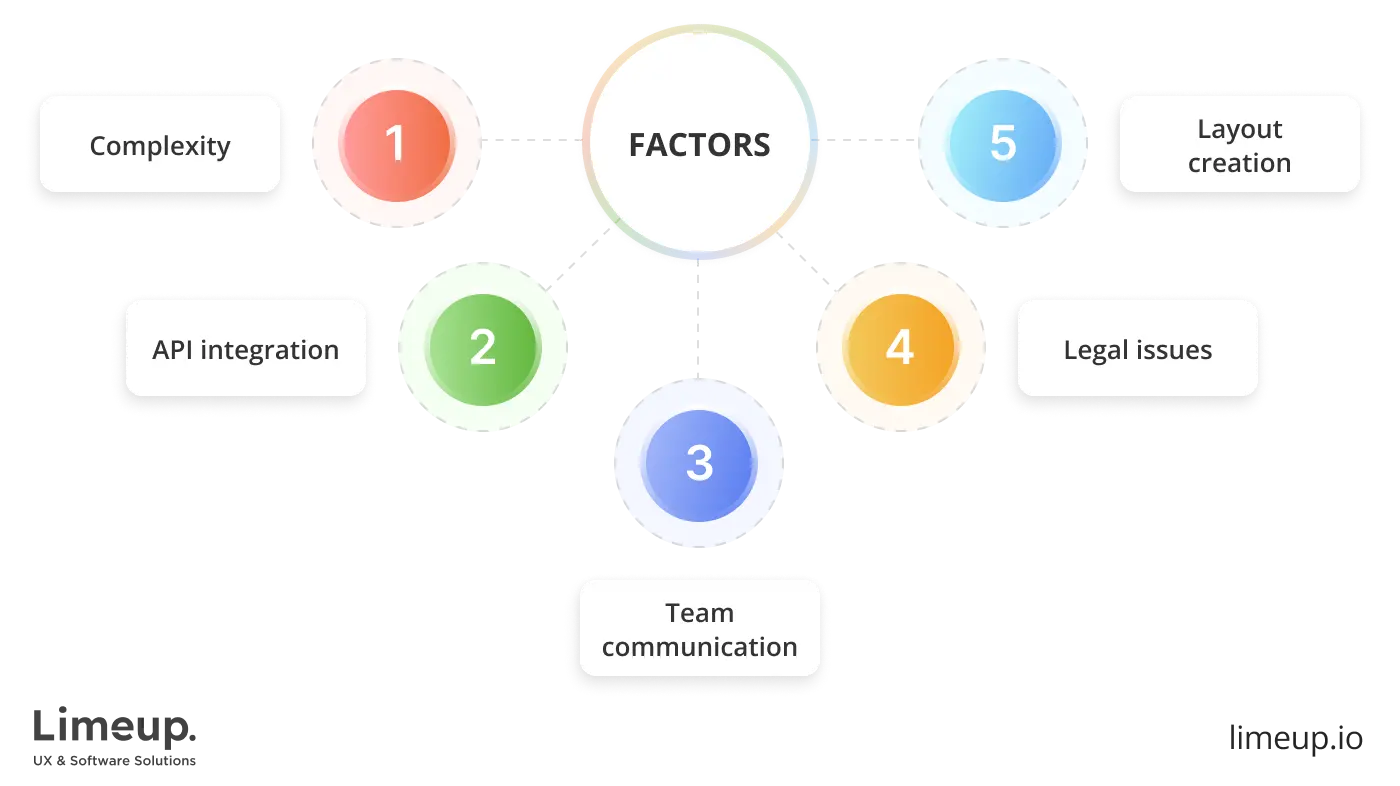
— Complexity
The principal element in working out how long does it take to develop an application emerges from its basic nature. The nuts and bolts of your endeavor demand examination because you have to determine whether it consists of standard features or represents a comprehensive platform that connects with other service providers, stays in sync with the moment and accumulates extensive user bases.
Utility applications such as weather trackers and to-do lists stipulate less building duration than social media or eCommerce programs because they are simpler to design. eCommerce tools compel additional months to complete production when they incorporate components like payment gateways, product catalogs, user authentication.
— API integration
Current applications call for multiple third-party services, such as social media authentication, payment gateways, and location determination services. Such additional components may cause the time required to develop an app to stretch longer than anticipated, as they introduce extra sophistication into the construction cycle.
The APIs of third-party providers may undergo updates which force you to dedicate additional work. We revealed that mobile solutions incorporate at least one third-party service, making up over sixty percent of all smartphone systems. However, connecting to external systems may slow down workflows due to compatibility issues and integration hold-ups.
— Team communication
The project faces delays as misaligned expectations surface when the design workforce, coding crew and product managers operate independently from each other. Bigger collectives produce additional obstacles to the communication flow. Time delays from the designers which precede unclear specifications which put developers at roadblocks will create subsequent delays in the entire project lifecycle.
Project Management Institute (PMI) research indicates that poor communication stands as the primary reason behind project delays since 56% of programming crews identified it as a timeline culprit.
— Legal issues
Some business sectors encounter issues in mobile platform design because of existing legal rules and obligations. Developing tools for healthcare, finance, education necessitates a sharp focus when aiming to make an app, as maintaining strict compliance standards substantially impacts the design and initiatives stages.
Applications functioning inside financial regulations have to conduct security audits that also follow GDPR and PCI-DSS protocols. Our plan incorporates necessary legal safeguards to meet statutory standards, extends launch duration, and provides assurance both for success and user trust.
— Layout creation
Additional depth in design extends the project schedule in opposition to our previous discussion about design. A longer interval will be obligatory to create perfect solutions when your app asks for advanced customized user interface elements and interactive visual effects.
The execution period shortens when code ninjas from application development companies in the UK and around the world use ready-made aesthetic components with basic layout structures. The choice to include wireframing, prototyping, and user feedback loops may push back the schedule by several weeks, but it leads to better overall user interaction.
What are the stages and timelines of application development?
Mobile software creation functions like artwork creation since each point maintains its individual function, ignoring any step would be similar to painting without a base. A defined path with strict deadline pressures leads to successful apps in the process. The progress from initial thought to downloadable software requires different frames and specific difficulties with distinct targets throughout each cycle.
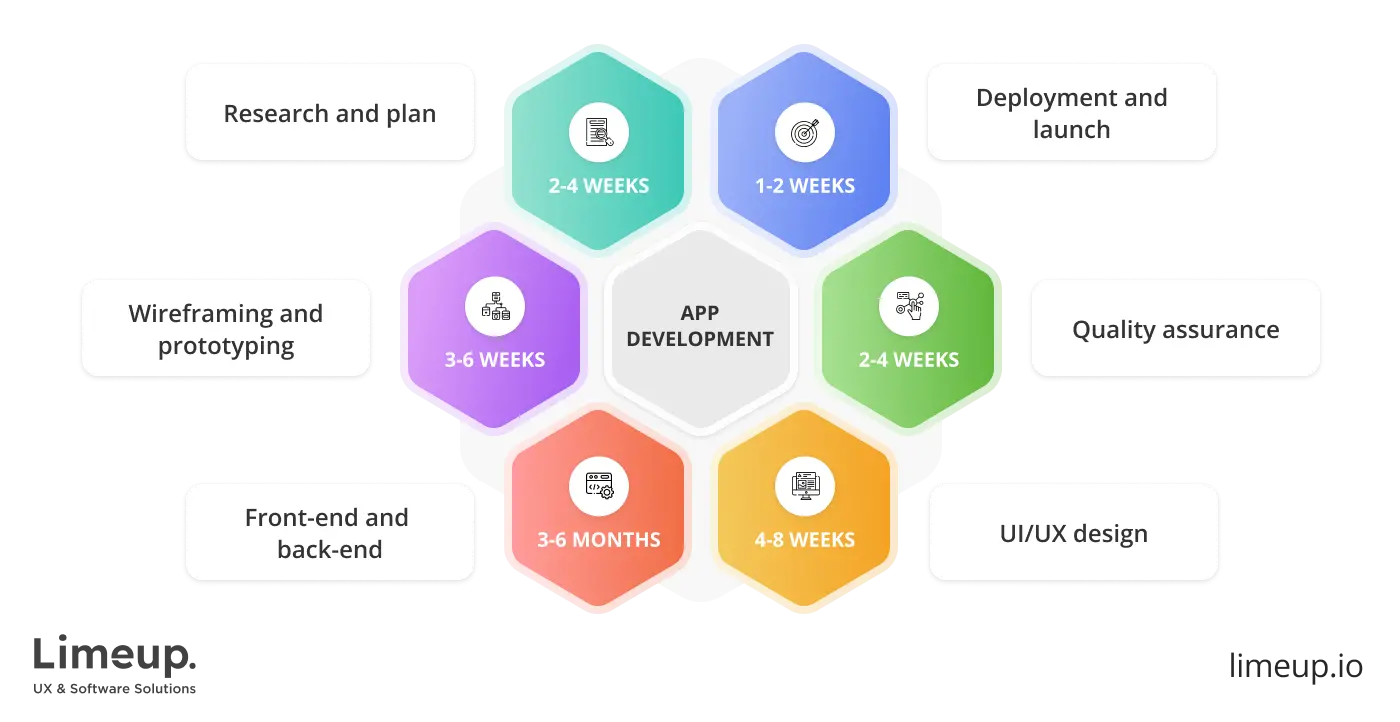
-
Research and plan (2-4 weeks). First of all, we at Limeup start with analysis and outline. The writing of initial program code must always follow a foundation step. The starting point encompasses market research and user studies with specific identification of the application’s main goal. How long does it take to develop a mobile app hinges on this starting point, as a well-laid plan may markedly speed up the entire cycle.
Businesses that hurry the planning during this period eventually need to reverse their decisions, which leads to project duration expansion. Proper preparation allows developers and designers to stay coordinated from the start, shrinking maintenance efforts by weeks or multiple months.
-
Wireframing and prototyping (3-6 weeks). The programming flow starts better with an early visualization of the app design. The wireframe design functions as a blueprint that shows which screens users will visit while displaying their structural particulars and important capabilities. Early usability problems become detectable through feedback loops by subjecting prototypes to real user evaluations.
The omission of this step results in expensive redesign stages that must be undertaken. According to the Interaction Design Foundation analysis fixing a usability deficit in design before construction starts costs ten times less than post-deployment fixes.
-
Front-end and back-end (3-6 months). Here, making an app begins to manifest as developers implement its structure. Development occurs through simultaneous work on visual layer interface traits, server-side database components, functionality, and programming interfaces.
Engineering native systems which operate independently on iOS and Android platforms normally extend the building period beyond cross-platform solutions including React Native and Flutter. From our 10 years long experience, we know that typical duration for building complete medium-hardness applications amounts to 4.5 months on average.
-
UI/UX design (4-8 weeks). The final appearance of an app influences user interface behavior and designers optimize these factors because they directly affect how people use product. As for how long does it take to build a mobile app, the duration may vary.
The length of time needed for app movement depends on how many animations and detailed microinteractions are present because minimalist interfaces tend to be faster. Various researches indicate that 88% of users stop using apps because of subpar usability which demonstrates this stage requires more than basic layout aspects like color choice and font selection.
-
Quality assurance (2-4 weeks). Users will never tolerate a problematic application. Testing ensures cohesive performance across different devices, operating systems, and screen sizes. Functionality, security, performance assessments are central at this milestone to eliminate potential roadblocks.
A well-optimized app enhances user retention, while a flawed one drives them away. In fact, only a small fraction of online shoppers complete their purchases — 83% of desktop carts and 90% of mobile ones are abandoned. This points out a simple truth: a frustrating experience sends users packing.
-
Deployment and launch (1-2 weeks). To publish a product simply cannot be achieved through a single press of the “publish” button. Both Apple’s App Store and Google Play Store maintain strict criteria for new submissions which results in delayed launch dates for rejected mobile tools.
Hire professional app developers who stay in the driver’s seat long after the launch, monitoring performance to keep the gears running smoothly. For businesses testing the waters with user feedback before going full throttle, a soft launch becomes the go-to move, though it often pushes back the completion date by several weeks.
How much time is needed to create different types of apps?
The duration to build an application primarily depends on three key factors: level of difficulty, integrated features and system requirements. A basic digital system usually asks for several weeks for creation but large platforms obligate more than a year for completion. Different mobile software creation schedules exist for various projects, so this article explores their production phases.
Simple mobile application
A simple product demands a short period to build an app with basic functionality such as task management, mathematical calculations or document annotation capabilities. Such programs prerequisite 2 to 4 months to develop since they have a no-frills setup running on the back-end’s tiptoes.
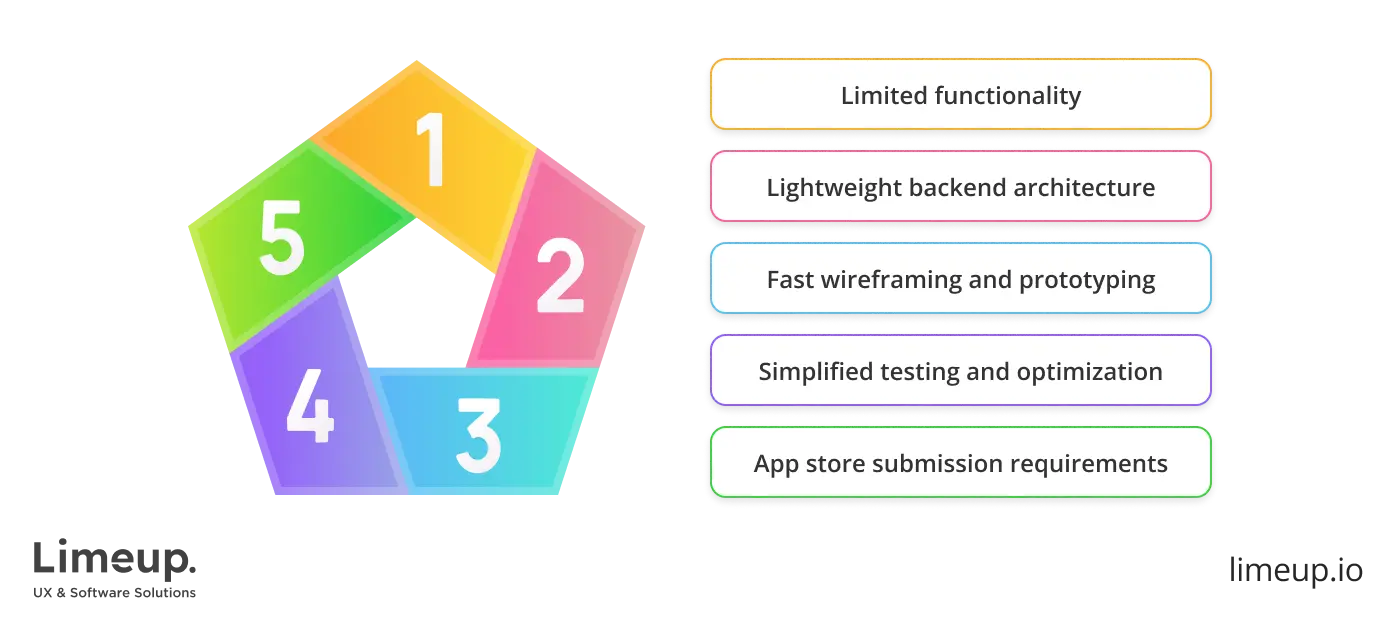
What influences the timeline?
- The primary aim of simplicity governs the wireframing and prototyping process, allowing it to be completed in a few weeks.
- The development and examination procedures stay clear-cut because fewer facilities and non-complex integrated components exist.
- Users who want to post their apps in Google Play and Apple’s App Store are mandated to follow the rules before completing a fast submission.
Example: A fitness tracking app that counts steps and calculates caloric burn without needing user accounts or cloud backup functions may have an 8 to 12 week duration.
The procedure for easy services does not last very long but designers must pay deep attention to all aspects during creation. User satisfaction partly depends on having a clear interface, flawless operation and top-notch visual appearance to achieve effective results. Basic applications have to pass through usability testing combined with optimization steps to operate fluently on all devices.
Medium complexity apps
How long does it take to create an app of mid-elaborateness? Developing apps that demand user authentication, instantaneous data syncing, API connections, and advanced user interface components typically necessitates 4 to 9 months to complete. This pattern includes social media platforms, separate from messaging and eCommerce applications.

Why does it take longer?
- Setting up the back-end calls for more work to build a stable database framework and integrate secure login protocols.
- APIs used for billing, location monitoring, and social network logins make design more challenging.
- The app ought to function optimally across miscellaneous network quality levels and hardware platform configurations.
Example: A ride-hailing application that combines GPS tracking attributes with payment processing and rider-driver communication abilities requires 6 to 9 months to create and test in its entirety.
Validation of average-tier systems demands multi-cycle testing which verifies system capacity for various operational situations and multiple users. Security measures need implementation specifically when the app handles financial transactions and user data. Quality control and debugging will extend the schedule, as each aspect demands thorough testing before it hits the public.
Complex apps
Creating fintech platforms, healthcare products, expansive eCommerce systems infused with AI technology involves extended periods. To create an app of this scale, the manufacturing course may span from 9 months to more than one year because they require multiple functions, security protocols and substantial infrastructure setup.
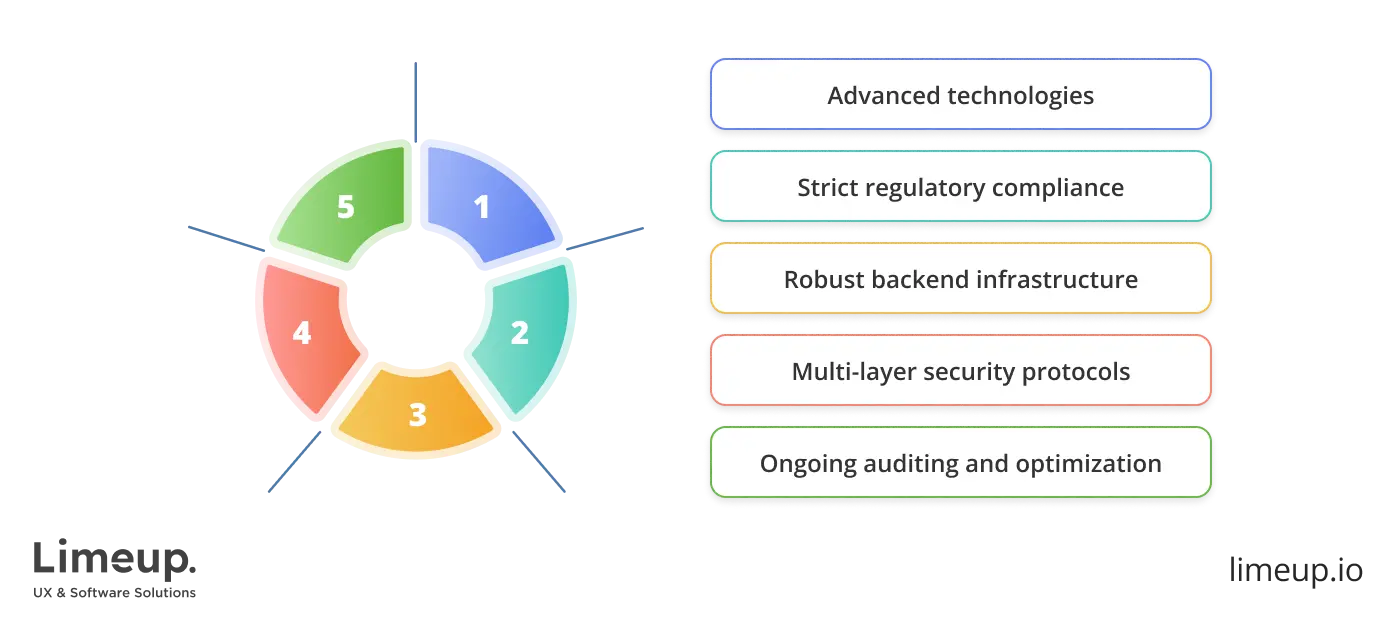
What makes it time-intensive?
- Research and probe phases lengthen the period of production because of machine learning or augmented reality and blockchain implementations.
- The course of action becomes extended because financial and healthcare applications must satisfy thorough regulatory specifications.
- Back-end systems must incorporate strong architecture capabilities to handle large user volumes when engineering applications for high-traffic environments.
Example: Developing a mobile banking system that entails multi-layer authentication coupled with fraud detection and encrypted transactions needs approximately 1 year to 1.5 years of proper time for crafting.
High-tech solutions necessitate continuous enhancement, with safety audits and regulatory conformance testing conducted even after completion. High-traffic platforms must support user activity ranging from thousands to millions of concurrent users.
When you decide to hire mobile app design experts, expect a more protracted venture. Due to the integration of load balancing, data encryption, cloud infrastructure, mobile app development the process often drags on.
The planning level extends even further for applications that must meet strict regulatory standards, like those in finance and healthcare. Continuous checks and gradual adjustments ensure the final product satisfies all benchmarks, but completing the project requires patience and endurance.
How can the mobile app development timeline be sped up?
Mobile solution production is often a race against the clock, where every minute counts. In the battle for market dominance, quickening the production process is vital to outpace the competition. The process of creating a digital solution is often lengthy, but by employing the proper tactics, you are able to speed up the time it takes to reach completion.
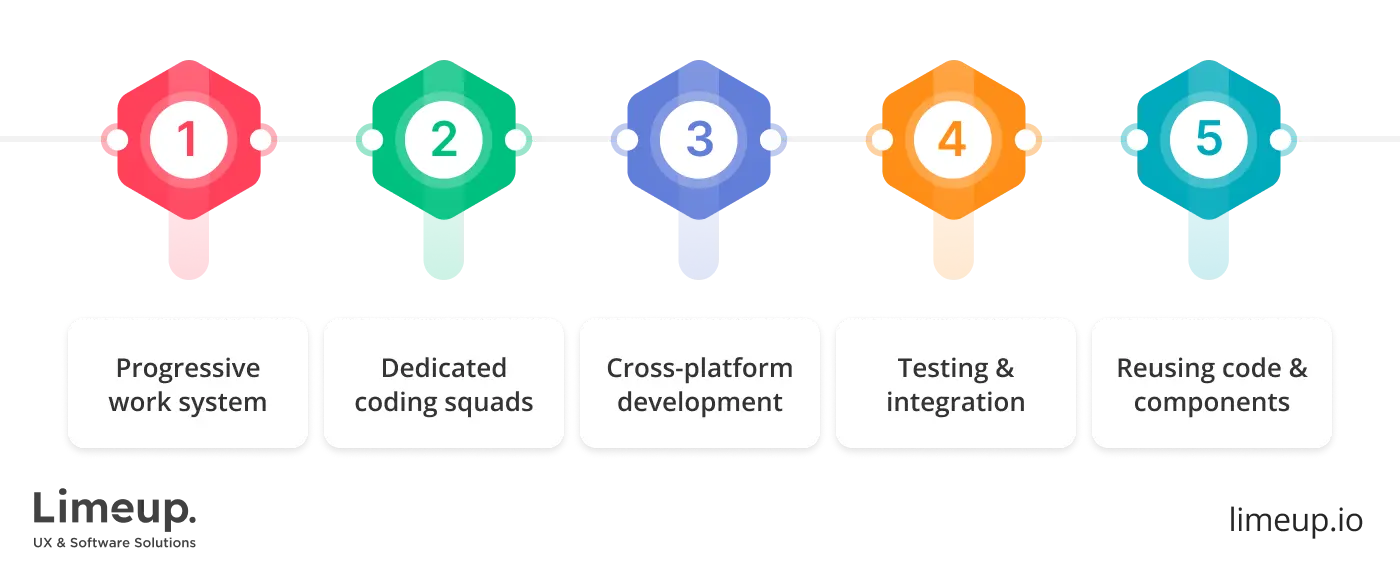
Progressive work system. Agile practices create a structure that refines processes and maximizes output efficiency. Through sprints, it protects your product by splitting work into small chunks which helps staff stay adaptable and maintain a focus on present priorities.
The project follows continuous feedback while using an iterative method which delivers fast project completion. Limeup uses an Agile approach to produce your product efficiently along with scheduled milestones which provide total transparency.
Dedicated coding squads. A tight-knit crew of pros is able to compress the duration and keep things on a steady course. Precision-driven mobile design combined with back-end engineering expertise and quality assurance discipline allows both tasks and problems to be resolved faster through more efficient execution.
Note that Limeup consists of professionals who understand particular sectors which results in exceptional work quality while minimizing program flaws.
Cross-platform development. The process of developing an application may be accelerated by universal frameworks like React Native and Flutter. A single compatible codebase for both Android and iOS enables tech gurus to save time since they create programs that work across platforms.
We have to mention that placement of strong emphasis on clear communication through daily standups, progress reports, transparent collaboration tools, ensures that everyone is on the same page, and adjustments are made as needed to avoid delays.
Smart testing and continuous integration. Fusion of automated testing and continuous integration enhances effectuality while safeguarding quality. The system identifies glitches in each stage to minimize time spent on manual testing and protect announced facilities from breaking. Refining validation practices fast-tracks production cycles and fortifies the final product’s functionality and resourcefulness.
Reusing code and components. Using pre-built components and reusable modules may dramatically reduce the efforts spent on coding. Instead of reinventing the wheel, programers have the ability to tap into existing code blocks for authentication systems, push notifications, payment integration — aspects that frequently appear while developing an app.
The success of any project depends on a plan that has been carefully designed. The path becomes simpler to navigate with defined direction because this eliminates operational complications and ensures deadline compliance.
Since implementation begins with adequate groundwork, organizations uncover landmark moments they must pass while managing resources correctly and identifying potential challenges ahead of time.
When considering how long does it take to code an app, remember that the clock ticks differently for each app, with the chronology fluctuating based on the app’s technical complexity and the breadth of items integrated into the design.
In summary
Numerous elements shape the app development timeline: the subtlety of the concept, the platform of choice, the personnel dynamics, and the approach to overseeing the project. Each step, from ideation to final release, has an impact on the overall duration and the hurdles encountered along the way. When guided by strategic planning and expert input, delays are minimized and productivity is maximized.
When building an app, surround yourself with a collective that plays to win and keeps their eyes on the prize. Limeup offers deep industry knowledge, strong technical capabilities, and a clear rollout workflow. Leave a message for us and take the leap with certainty.

